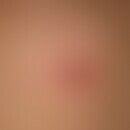Synonym(s)
DefinitionThis section has been translated automatically.
AKASI is the acronym for "actinic keratosis area and severity index". This is a well evaluated "scoring" index for the quantitative and qualitative assessment of actinic keratoses on the head. The aim of the score is to enable an individual risk stratification of patients with actinic keratoses (in situ carcinomas) based on easily ascertainable clinical data. In this context, it is important to differentiate between patients with a high need for therapy and the associated risk of developing invasive squamous cell carcinoma and patients with little or no need for therapy at the time of examination.
General informationThis section has been translated automatically.
Clinical studies have shown that patients with squamous cell carcinoma have significantly higher AKASI scores. In another clinical study, a strong correlation between the AKASI score and the previously established PGA score (Physician Global Assessment) was demonstrated (Dirschka t et al. 2017).
With target parameters such as AKASI 75, AKASI 50, etc., clinical studies (analogous to the well-known PASI parameters) can be evaluated and compared. The AKASI is above all also suitable for everyday use and useful in routine clinical work. Thus, this score is also suitable for standardized evaluation of the extent and severity of the disease in BG procedures.
To determine the AKASI score, the scalp is divided into 4 topographic regions (see also Fig.):
- Upper part of the scalp (capillitium: 40%)
- Forehead (20%)
- Left cheek + chin, nose, ears (20%)
- Right cheek + chin, nose, ears (20%)
In each region, the percentage of the area affected by actinic keratoses is first estimated.
Then the definition of the distribution pattern is made:
- no infestation
- solitary or loosely distributed
- grouped
- grouped and confluent
- extensive
A clinical assessment of the severity of actinic keratoses follows, with the following clinical parameters being included in the overall score:
- erythema grading (no erythema/mild erythema/moderate erythema/intense erythema/saturated erythema)
- Thickness grading (no consistency increase/low, weak palpable consistency increase/clearly palpable elevation/thick hyperkeratotic plaque/very thick hyperkeratotic plaque).
An AKASI calculator app from Allmirall is available for calculating the AKASI score of all head areas together (0 to 18).
Note(s)This section has been translated automatically.
A web-based calculation system can be uploaded over the Internet for the different operating systems:
- Go to AKASI Calculator web version: https://akasicalculator.com/
- Download AKASI Calculator for Android devices: https://play.google.com/store/apps/en
- Download AKASI Calculator for iOS devices: https://itunes.apple.com/es/app/akasi...
LiteratureThis section has been translated automatically.
- Dirschka T et al (2017) A proposed scoring system for assessing the severity of actinic keratosis on the head: actinic keratosis area and severity index. J Eur Acad Dermatol Venereol 31:1295-1302
- Olsen EA et al (1991) A double-blind, vehicle-controlled study evaluating masoprocol cream in the treatment of actinic keratoses on the head and neck. J Am Acad Dermatol 24:738-743
- Schmitz L et al (2016) Actinic keratosis: correlation between clinical and histological classification systems. J Eur Acad Dermatol Venereol 30:1303-1307
- Werner RN et al (2013) The natural history of actinic keratosis: a systematic review. Br J Dermatol 169:502-518.




